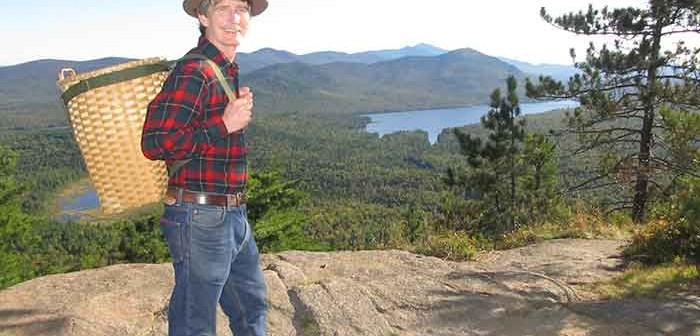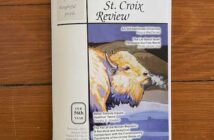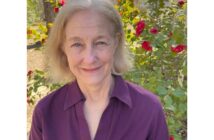Last month I read Ed Kanze’s new book on the Adirondacks, Adirondack Life and Wildlife in the Wild, Wild East and on a whim, contacted him through his website and asked to sign up for one of his guided tours. One thing led to another and since he lives near my family’s place outside of Saranac Lake, he ended up coming over on a rainy day for lunch, talk and a quick walk in the woods. I was visiting my dad with a few close friends and we’d spent the week hiking, fishing for bass (They’re biting in September; throw something over and it’s going to be grabbed.) and everyone’s favorite: sitting at the long cherry red dining room table looking out over the lake while eating camp gourmet meals and telling stories.
Ed Kanze has a great a passion for the Adirondacks and why wouldn’t he? This is a six million acre state park in northeastern New York – the largest national park in the lower 48 and bigger than Vermont. It is not, however, a museum. There are villages scattered throughout and if you can manage the winters, which may have temperatures plummeting to 42 below, you can live there. Some fun facts: several dozen mountains ranging from 1,200 to 5,000 ft., 1,200 miles of riverway, at least 3,000 lakes and ponds not to mention various and sundry wildlife – though no pandas. Even the moose have returned (two sightings recently on our property) and my last day there, I was rowing a guideboat down the lake and a bald eagle appeared and dipped over the boat house. We had been seeing him on a regular basis so he must have been living nearby; I even spotted him having lunch down by the highway one afternoon.
In the Adirondacks we are so close to nature and beauty we wear it as a favorite jacket. Up close. Warm and comforting. I can see why tourism is so popular.
I asked Mr. Kanze, a naturalist, what made the Adirondacks so unique and he explained it was “a mixing ground between the south and the north.” We have the “classic forest that goes south, the birds and the flowers and then it hits the Adirondacks and peters out. Then it changes because of Canada – with shallow soil, short growing season, Canada’s conifer forests, Canadian wildflowers and birds then this peters out.” It’s “north and south intermingling on a cellular level. When you step out in the woods, you feel the excitement and diversity.”
Mr. Kanze’s new book, his fifth, tells the story of his family’s ties to the Adirondacks and the adventures he and his wife Debbie have had renovating an old summer house on the Saranac River and becoming parents late in life (like me). Imagine a wilderness Year in Provence with stories of bear on the porch, fluorescent mice and how Kanze’s ancestors set down roots in the 1700s and made their way in this frontier. Throughout the book, Mr. Kanze raises the question all writers ask: Should I carry on doing this? And in his case: Should I carry on battling the elements and living in the Adirondack Park? But East, West, Home is Best and he always seems to circle back to staying put, writing, and working as a lecturer and professional guide both in the Adirondacks and overseas.
The prose is poetry. “Silver stars glitter on universal black velvet. The thrush, its breast spotted, back olive, and rump and tail a dusty rusty red, keeps watch. With sharp eyes and a brain not quite the size of a table grape. . .” Or writing of the unique forest and green of the mountains, “ the dark, glossy green of balsam fir, the luminous yellow-green of sugar maple, the cool frosty green of white and black spruce, the deep blue-green of white pine, the wavering light-and-dark green of aspens trembling in a breeze.” What I most enjoyed about Mr. Kanze’s book is it helped me look at the Adirondacks (which I have been visiting for 51 years) through sharper eyes, encouraging me to appreciate the region’s beauty and marvelous local color even more.
From our conversation a few weeks ago, I learned he likes to write at night after 10 PM. Favorite authors and works are John Burroughs, essays; Charlotte Walker, The Art of Seeing Things; and Edward Abbey, Desert Solitaire. He admits non-fiction is easier to publish than fiction though he has finished a novel on explorer Henry Hudson and a murder mystery, both almost ready to be published.
When Mr. Kanze glances out his office window, he can see Catamount Mountain, a steady rise, grey rockscapes, spikey conifers and on some days, all backed by a hard perfect blue sky. When I look out my window, I see a black and white snake of asphalt road, sorrowful lawns and summer day lilies gone brown. Authors like Ed Kanze teach me to observe more respectfully and when I do this, I see and hear so much more.
The neighbor’s crepe myrtle has its last raspberry tinge since Fall is on her way and underneath the tree, bright white mushrooms the size of saucers have taken root. They are so big I can imagine gnomes living underneath. My cat Mio now spends a lot of time sitting under the Japanese maple out front; he’s too lazy to hunt, no worries there – perhaps the tree roots he settles next to are cool to sit on. If I open the window, I can hear the reassuring hum of distant traffic and the caw of crows flying over the house. Birds I used to dislike until I found out how bright they are.
In Virginia it is Indian Summer. . .
Adirondack Life and Wildlife in the Wild, Wild East by Edward Kanze
http://www.edwardkanze.com.



